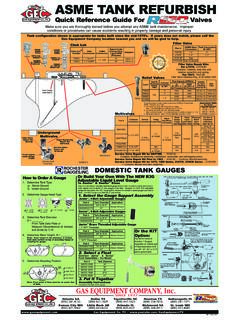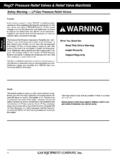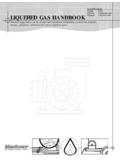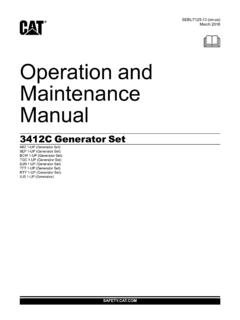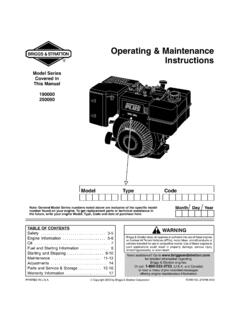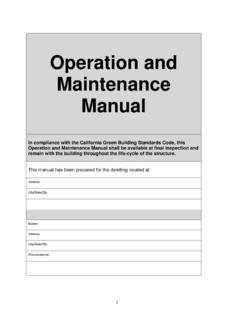Transcription of Installation, Operating & Maintenance Manual
1 installation , Operating & Maintenance ManualSeries 75 Electric ActuatorsA separate installation , Operating & Maintenance Manualexists for the Dataflo C and P versions of this product- contact Norbro for further Norcom product complies with thefollowing European directives and Compatibility73/23/EECLow Voltage Directive92/59/EECG eneral Product SafetyStandardsEN 50014:1992 General RequirementsEN 60529:1992EN 60529:1989 Ingress protectionContentsInstallation, Operating & Maintenance considerations .. the actuator prior to use .. 2 2 3 overrides .. configurations .. the actuator to the valve .. 4 E Series mounted 4 Top mounted the actuator to the valve (modulating) .. installation and cam adjustment .. 6 adjustment .. re-assembly .. and trouble supply.
2 Connections .. 10 10 10 train .. 10 potentiometer option (single / dual).. description .. 11 10 - 23 actuator feedback potentiometer assembly (single / dual).. 25 & 30 actuator feedback potentiometer assembly (single / dual) .. 12 potentiometer to actuator 13 to options .. 14 potentiometer adjustment .. potentiometer calibration (single) .. 14 potentiometer calibration (dual) .. 15 5 Heater / thermostat .. 17 6 Mechanical brake brake assembly .. the bracket to the actuator .. 197 Centre-off option sizes 10 rotation .. of the centre-off option .. of the centre-off option .. the centre-off the actuator .. DC switching and 258 Extra limit switch option (M1 or M2) sizes 10 - extra limit switch(es).
3 The cam(s).. the switch(es) .. 269 Cycle length controller option (CLC) sizes 10 - 2810 Exploded view drawings .. 30 Series 75 sizes 10 - 23 .. 30 Series 75 sizes 25 - 30 .. 32 Page2 DESCRIPTIONThe distinctive yellow and black housing of Worcester Controls series 75 electric actuators are known throughout the world for their quality of build and low Maintenance . The standard range of quarter turn actuators, utilising only threesizes of housing, can provide output torque from anywhere between - 345 Nmvia a permanently lubricated gear train. The AC actuators use a capacitor start /run motor which are equipped with an integral thermal overload protection systemand automatic reset. All series 75 electric actuators have Manual override CONSIDERATIONSThe series 75 electric actuators are electro - mechanical devices and are subject tonormal wear.
4 The life of the actuator is dependent on the application andenvironment in which it is used. If used in high temperature areas the duty cyclewill be affected (consult Worcester Controls for revised duty cycle and operatingtimes). It is highly recommended by Worcester Controls that for actuators which areto be mounted outdoors use a heater / thermostat in conjunction with a drain /breather kit. The operation of the actuator and the heat that is generated during thecycles from the electric motor(s) heats the air in the enclosure and expands. Whenthe actuator cools, the moisture in the air condenses and water droplets form onthe inside of the actuator cover. The more cycles the actuator completes the morewater that is formed in the enclosure. The heater / thermostat is used to keep thehousing at a constant temperature and the drain / breather to let any water escapethrough the lowest point in the actuator base if THE ACTUATOR PRIOR TO USEP rior to use, the actuators should be stored in areas that do not exceed 85%relative humidity and which have a temperature range of between - C.
5 Donot store in areas where acidic, alkali fumes or radiation is present or within 50 feetof any source of actuator enclosure has an internationaly recognised rating of IP 66. To upholdthe integrity of the enclosure a conduit that is equal to or better than IP66 must electrical conduit entry size is 1/2" NPT for actuator sizes 10-30 with exceptionof the size 23 which has a 3/4" INTEGRITYFor both the AC and DC standard electric actuators the actuator shaft will stoptravelling if the power supply to the motor(s) is interrupted in any ManualSeries 75 Electric ActuatorsIOM ManualSeries 75 Electric series 75 product coding is divided into field (A-M) as detailed below; OVERRIDESThis facility should only be used when the electrical supply to the actuator is turned'off' or when the actuator has failed after the electrical supply has been the actuator has been manually overridden the motor will drive until the clutch re-engages driving the valve to the end of 10-23:Pull the declutching knob up to expose the shaft flats.
6 Using a correctly sized spanner on the flats rotate the actuator shaft to the desired position. To re-engage, return the actuator shaft to the original position of disengagement and remove the spanner. The knob will drop down covering the 25/30:Simply rotate the handwheel in either direction to achieve the desired :The actuator should only be manually operated over the quadrant that thecams are adjusted for. Operating outside of this quadrant could possibly disrupt theworking of the actuator / valve assembly. Copyright Worcester Controls (UK) 23 4 5 6 789 10 11 1 2 13 14 151617 18 1920 21 22 23 24 Example:10 754W 240 ASize 10 series 75 electric actuator60% Duty cycleGasket interface seal - waterproof240 VAC motor voltageFIELDDIGITSDESCRIPTIONA1 & 2 Actuator sizeB3 - 5 Actuator standard variantsC6 & 7 Actuator seriesD8 Duty cycleE9 Enclosure optionF10 & 11 Limit switch optionG12 - 15 Motor voltageH16 Cycle length control optionJ17 DFC 17 Setpoint input signalK18 & 19I 75 & DFP 17 input signalL20 DFC 17 Process input signalM21 - 24 Special CONFIGURATIONSa)Standard mounting configuration (In-line).
7 This is where the actuator and valve are 'in-line' with each other so that the closed position of the actuator is also the closed position of the )Alternative mounting configuration (cross line).This is where the actuator is mounted 'across' the line of the valve. If space is limited and this is the only actuator / valve orientation that can be achieved then the standard working quadrant of the electric actuator should be changed. See NOTE in section THE ACTUATOR TO THE VALVE (non modulating)NOTE:All mounting instructions are detailed for standard configuration only (in-line). For alternative mounting configuration rotate the bracket through 90 when assembling to the actuator THROUGH BOLTED MOUNTED VALVES (non ISO mounting)a)To attach the mounting bracket to the actuator base, orientate the mounting bracket so that the solid side of the bracket is parallel with the conduit tighten the four screws and lock washers using a correctly sized tool.
8 Prior to assembling the actuator to the valve, ensure that the valve stem and actuator output shaft are correctly : Ball valves can trap pressurised media in the cavity. If the valve isinstalled in line and is or has been in operation, make sure there is NOpressure to or in the valve before removing any body )Close valve so that the stem flats are perpendicular to the line of )Remove the wrench retaining nut, spring washer and )Remove the two upper body bolts and nuts or the four upper socket head cap screws from the )Locate and centralise the coupling on the valve )Lower the actuator and mounting bracket assembly over the coupling and engage the actuator output drive and position the solid sides of the bracket over the valve end )Secure the mounting bracket to the valve by using the new longer body bolts and nuts or the old socket head cap screws.
9 Tighten the body fasteners as stated in the valve 'E' SERIES MOUNTED VALVESa)To attach the mounting bracket to the actuator base, orientate the mounting bracket so that the solid side of the bracket is parallel with the conduit tighten the four screws and lock washers using a correctly sized tool. Prior to assembling the actuator to the valve, ensure that the valve stem and actuator output shaft are correctly ManualSeries 75 Electric ActuatorsIOM ManualSeries 75 Electric Actuators5b)Close valve so that the stem flats are perpendicular to the line of )Remove the wrench by unscrewing the set )Locate and centralise the coupling on the valve )Lower the actuator and mounting bracket assembly over the coupling and engage the actuator output drive and position the solid sides of the bracket over the valve stem mounting )Secure the mounting bracket to the valve by using the mounting bolts provided.
10 Tighten the body fasteners as stated in the valve TOP MOUNTED VALVESa)To attach the mounting bracket to the actuator base, orientate the mounting bracket so that the solid side of the bracket is perpendicular to the conduit entry. Loosely tighten the four screws and lock washers using a correctly sized tool. Prior to assembling the actuator to the valve, ensure that the valve stem and actuator output shaft are correctly )Close valve so that the stem flats or stem indication line is perpendicular to the line of )For the larger sized valve remove the wrench retaining screw and the smaller valves remove the wrench retaining nut, spring washer and wrench. For valves that use stop plates and stop pins that interfere with the ISO pattern on the valve mounting platform, follow the details below,i) Remove the split ) Remove the stop ) Remove the stop ) Fit the profiled ) Fit the split nut and tighten to the torque as stated in the valve )Locate and centralise the coupling on the valve )Lower the actuator and mounting bracket assembly over the coupling and engage the actuator output drive and position the bracket square on the valve mounting )Secure the mounting bracket to the valve by using the screws and lock washers provided.

